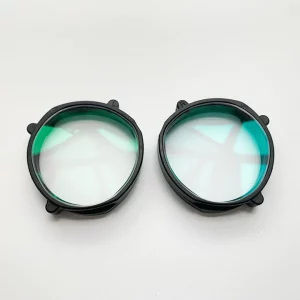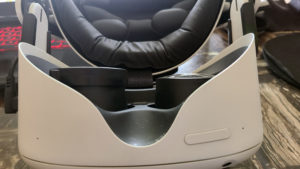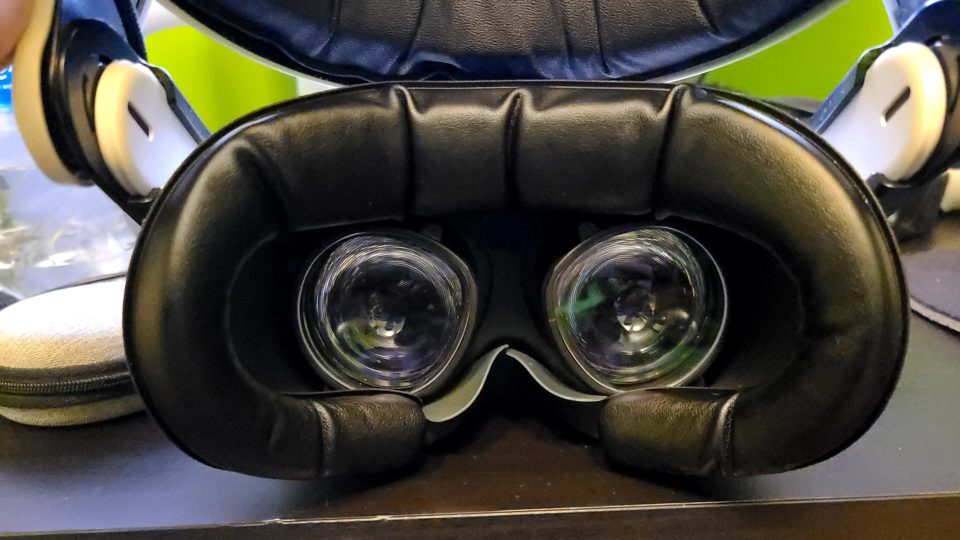Developer / Publisher – VR-Rock
Min. Price – US $56.99 / CAN $72.99 / EU €52.99 / UK £45.60
+ Shipping costs
Store Link – VR-Rock
Reviewed on – Quest 2
For some, putting on a VR headset can be a bit of a hassle as those with reduced vision can have a tough time seeing properly VR with most headsets not being able to accommodate the prescription glasses needed to see. Contacts might be an option, or you could use spacers that keep the glasses from rubbing the HMD lenses but for some, neither of those choices is ideal which brings me to VR-Rock’s custom prescription lenses which also offer optional blue light & glare filters to help reduce eye strain for those lengthier play times. These lenses are available for the Quest, PSVR & many of the PCVR headsets and for the purposes of this review, I’ll be using the Quest 2 version.

2 magnetic mounts & 2 lenses are all you need.
So, right off the hop I need to specify that, as far as I know, outside of some mild color-blindness, I don’t use nor need prescription lenses so I can’t comment on the quality of VR-Rock’s custom prescription lenses though customer testimonials praise the product (like this dude!). When you visit the website you can choose your exact needs for each eye with sphere, cylinder & axis drop downs, or you can even upload your own prescription directly accommodating just about anyone who has nearsightedness or farsightedness. Additionally, you can add both anti-glare and blue light filters to the lenses and for the purposes of this review, I’ll be reviewing the lenses with those latter 2 options in place.
Out of the box, there’s not a lot here as the lenses come in a small zip case with the 4 pieces, 1 mount and 1 lens for each eye, tucked inside in 2 separate pockets. Each mount and lens are marked left or right and attach to each other using 3 small magnets for easy placement & removal. It would have been nice to have little info sheet tucked in for lens care, but the website lists these details, which are fairly standard for VR lenses anyways. Installation is simple as you need to place the mount on the corresponding headset lens and then place the actual lens on top of it. I found the magnetic mounts to be a tad tricky to put on as they do fit fairly tight around my Quest 2’s lens housings, but with a little bit of force got them in place and I don’t expect anyone to have too much difficulty here. Once on, they stay in place thanks to some small clips and take a fare bit of force to remove though there really isn’t any reason too take them out. The lenses can only fit one way so there is very little room for error with the 3 magnets keeping the lenses in place and in my testing over the last month, they never slipped once.

The height of the lenses look drastic, but they feel just fine in the headset.
As far as my thoughts on the lenses ago, they work as advertised and once in the headset, I really couldn’t tell they were in place offering me crystal clear viewing of my Quest 2 lenses, so much so that I have left them on and plan on keeping them on as they also offer an additional layer of protection for the Quest 2 lenses and prevent them from getting any scuffs or scratches. I could feel them just lightly touching the bridge of my nose and if my headset wasn’t tightened enough, a little bit of shake did have me feeling them a bit more, though they were never uncomfortable and despite how much closer the lenses were to my face, my eye lashes never touched the lenses. VR-Rock’s lenses also come with 5 coatings including Anti-scratch, anti-static, anti-UV, anti- reflection and an easy to clean surface requiring a simple microfiber cloth or cloth & soap/water combo for any kind of excessive messes meaning that, overall, these lenses are just as easy to maintain as the ones you are covering.
In regards to the blue light and anti-glare filters on my lenses, there is a definite reduction for the blue light though it’s very subtle and hard to notice unless I was testing out games intent on finding that difference. Anti-glare is supposed to help with any sort of light bleed that could seep into the headset and cause some minor reflection and I tried to test it out by letting in some light and thought I noticed some glare reduction but with the thicker padding that I use for my Quest 2, light bleed isn’t too much of an issue for me, but I like I said, it looks these lenses could reduce that if it is an issue for you.

They look perfectly fine once in place and never move!
All in all, I’m really happy with these lenses as, at the very least, they offer a semi-permanent way to protect my Quest 2 lenses from any sort of damage and offer those additional blue Light and anti-glare filters, the former of which I appreciate for those late night & longer gaming sessions. If I paid attention, I could feel the lenses resting against my nose but there was never any pressure applied and even after hours in the headset using games that require some dramatic movements, they never hurt or left a mark on my skin making them unintrusive and, for those that experience lens fogging, these seem to reduce that as well though this is something not promised by VR-Rock, I just noticed my lenses fogging up less since these have been installed. Bottom line here is that these work as advertised and if you do need to wear glasses in the headset, these seem to be a very good option.
What would I pay? So, this is where things get tricky as the base cost of these lenses looks to be $56 US and depending upon the severity of your needed prescription, that price could increase substantially. Adding Blue light or glare reduction will be an additional $10 each for a minimum of $76 US a pair which I think for those that wear glasses is a good price as they would make playing VR substantially easier. For those that don’t need the lenses, like me, that price is a much harder ask and more of a luxury purchase BUT one that could be warranted if you are looking for an easy way to protect your actual lenses or reduce the amount of blue light you take in.
VR-Rock provided The VR Grid with a sample of this product and, regardless of this review, we thank them for that!




